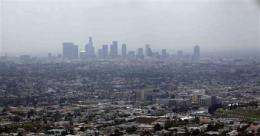Smog covers downtown Los Angeles, on Tuesday April 28, 2009. Sixty percent of Americans live in areas with dangerously high pollution levels despite a growing green movement and more stringent laws tackling air quality, according to a new study on air pollution. Los Angeles, Long Beach and Riverside remained the metropolitan area with the highest levels of ozone pollution as they have with every one of the last 10 reports. (AP Photo/Nick Ut)
(AP) -- Sixty percent of Americans live in areas with unhealthy air pollution levels, despite a growing green movement and more stringent laws aimed at improving air quality, the American Lung Association said in a report released Wednesday.
The public-health group ranked the pollution levels of U.S. cities and counties based on air quality measurements that state and local agencies reported to the U.S. Environmental Protection Agency between 2005 and 2007.
Overall, the report found that air pollution at times reaches unhealthy levels in almost every major city and that 186.1 million people live in those areas. The number is much higher than last year's figure of about 125 million people because recent changes to the federal ozone standard mean more counties recognize unhealthy levels of pollution.
Health effects from air pollution include changes in lung function, coughing, heart attacks, lung cancer and premature death.
"Six out of 10 Americans right now as we speak live in areas where the air can be dirty enough to send people to the emergency room, dirty enough to shape how kids' lungs develop and even dirty enough to kill," said Janice E. Nolen, the association's assistant vice president on national policy and advocacy.
Cities including Los Angeles, New York, Atlanta, Charlotte, Philadelphia, Washington D.C. and Baltimore have seen improvements in air quality over the last decade, the report said.
The Los Angeles-Long Beach-Riverside region of Southern California remained the metropolitan area with the highest levels of ozone pollution, as it has in each of the past 10 reports. Other metropolitan areas considered to have the most ozone pollution included Houston-Baytown-Huntsville and Dallas-Fort Worth in Texas.
The areas with the most short-term particle pollution or soot were Pittsburgh-New Castle, Pa.; and the California areas of Fresno-Madera, Bakersfield and Los Angeles-Long Beach-Riverside.
The cleanest metro area in all categories was Fargo, N.D.
The rankings in the "State of the Air Report" were based on ozone pollution levels produced when heat and sunlight come into contact with pollutants from power plants, cars, refineries and other sources.
The lung association also studied short-term and year-round levels of particle pollution, which is made up of a mix of tiny solid and liquid particles in the air.
---
On the Net:
American Lung Association of California, http://www.californialung.org
State of the Air 2009, http://www.stateoftheair.org
©2009 The Associated Press. All rights reserved. This material may not be published, broadcast, rewritten or redistributed.



















